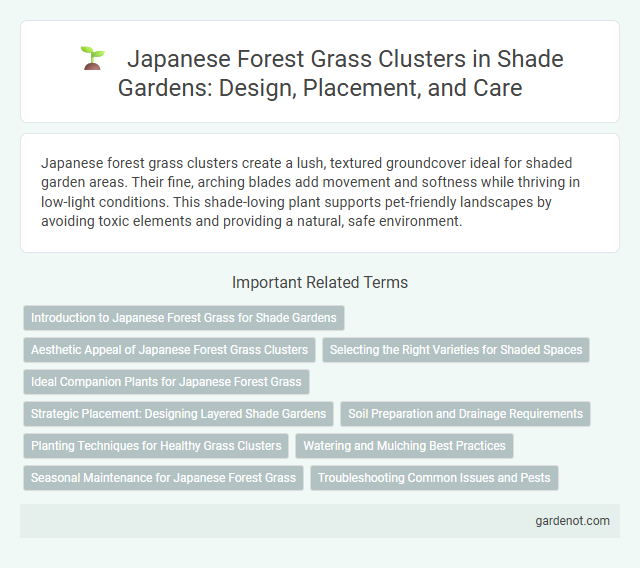Japanese forest grass clusters create a lush, textured groundcover ideal for shaded garden areas. Their fine, arching blades add movement and softness while thriving in low-light conditions. This shade-loving plant supports pet-friendly landscapes by avoiding toxic elements and providing a natural, safe environment.
Introduction to Japanese Forest Grass for Shade Gardens
Japanese forest grass (Hakonechloa macra) thrives in shade gardens, offering vibrant green to golden foliage that adds texture and color beneath trees. This low-maintenance, clumping grass prefers moist, well-drained soil and gradually spreads to create a natural, flowing ground cover. Its graceful, arching leaves provide seasonal interest and remain attractive from spring through fall, enhancing shaded garden spaces with subtle movement.
Aesthetic Appeal of Japanese Forest Grass Clusters
Japanese forest grass clusters (Hakonechloa macra) enhance shade gardens with their elegant, arching foliage that creates a graceful, flowing texture. Their vibrant green to golden-yellow hues provide striking seasonal color contrasts, enriching the garden's visual depth. These clusters form dense, low-growing mounds that naturally soften woodland edges and pathways, boosting the garden's overall aesthetic appeal.
Selecting the Right Varieties for Shaded Spaces
Selecting the right varieties of Japanese forest grass (Hakonechloa macra) for shaded spaces requires choosing cultivars that thrive in low-light conditions and maintain vibrant foliage color throughout the seasons. Varieties like 'Aureola' with its golden-yellow stripes and 'Alboa' known for its crisp white variegation are particularly effective at brightening dark garden corners. Proper selection ensures healthy growth, enhances ground cover, and adds texture to shade gardens with minimal maintenance.
Ideal Companion Plants for Japanese Forest Grass
Japanese forest grass (Hakonechloa macra) pairs wonderfully with shade-loving companions like hostas, ferns, and astilbes, which complement its cascading foliage texture and thrive in similar moist, well-drained soil. Ferns such as Japanese painted fern provide delicate fronds that contrast with the grass's arching blades, while astilbes add vibrant flower plumes to enhance visual interest in shaded garden areas. Combining these plants creates a dynamic, layered understory with varied textures and seasonal color, ideal for enhancing shade garden aesthetics.
Strategic Placement: Designing Layered Shade Gardens
Japanese forest grass cluster thrives in shaded environments, making it ideal for layering in shade gardens to create natural depth and texture. Strategically placing these clusters under tree canopies or alongside ferns enhances moisture retention and mimics woodland ecosystems. Their fine blades and arching form complement taller shrubs, establishing a balanced, multi-dimensional garden design.
Soil Preparation and Drainage Requirements
Japanese forest grass clusters thrive in well-drained, acidic to neutral soil enriched with organic matter such as compost or leaf mold to mimic natural forest floor conditions. Proper soil preparation includes loosening the soil to a depth of at least 6 inches to enhance root penetration and air circulation while preventing waterlogging. Installing a drainage layer or incorporating coarse sand improves water runoff, reducing the risk of root rot and ensuring optimal growth in shaded garden environments.
Planting Techniques for Healthy Grass Clusters
Plant Japanese forest grass clusters in well-drained, humus-rich soil with consistent moisture to promote healthy root development and dense growth. Space clusters adequately, typically 12 to 18 inches apart, to allow air circulation and reduce the risk of disease. Regular mulching and occasional division every two to three years help maintain vigor and prevent overcrowding.
Watering and Mulching Best Practices
Japanese forest grass clusters thrive in consistently moist soil, requiring regular watering to maintain a lush, healthy understory without waterlogging. Applying organic mulch, such as shredded bark or leaf litter, helps retain soil moisture, regulate temperature, and suppress weeds around these ornamental grass clusters. Ensure mulch is kept a few inches away from the base to prevent rot and promote optimal root health in shaded garden environments.
Seasonal Maintenance for Japanese Forest Grass
Japanese forest grass (Hakonechloa macra) requires careful seasonal maintenance to thrive in shade gardens, including light pruning in late winter to remove damaged foliage and promote fresh growth. Applying a layer of organic mulch in early spring helps retain moisture and regulate soil temperature during the growing season. Regular monitoring for pests and ensuring consistent watering during dry periods supports healthy development throughout the year.
Troubleshooting Common Issues and Pests
Japanese forest grass cluster (Hakonechloa macra) may experience yellowing leaves and stunted growth due to poor drainage or excessive sunlight, which disrupts its preference for shaded, moist environments. Common pests include slugs and snails that cause irregular holes in foliage, while aphids may lead to leaf distortion and sticky residue; regular inspection and organic slug pellets or insecticidal soap can effectively manage these problems. Maintaining consistent moisture, improving soil drainage, and ensuring adequate shade helps prevent stress-related issues and supports healthy growth in shade garden settings.
Japanese forest grass cluster Infographic

 gardenot.com
gardenot.com